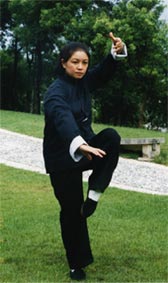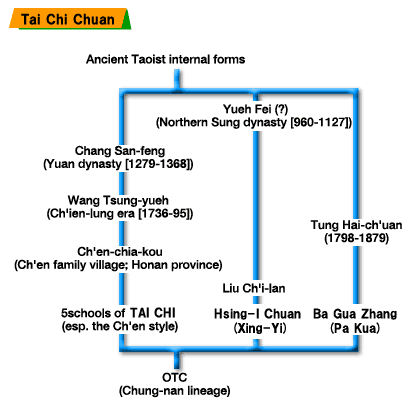Tai Chi Chuan(T'ai-Chi Ch'uan) as a Chinese Martial Art
 Tai chi Chuan is one art that arose out of the ancient Chinese philosophy surrounding the idea of the Great Ultimate; together with Hsing-I Chuan (Xing-Yi) and Ba Gua Zhang(Pa Kua), it completes the trinity of 'internal' martial arts.
When they hear the word "Tai Chi," many people think of a very slow-moving series of movements performed by the elderly to help them preserve their health. Although the system known as "Orthodox Tai Chi Chuan(T'ai-Chi Ch'uan)" (OTC) that was transmitted to the AJSSMAF does this, it is taught here at AJSSMAF in a carefully prepared curriculum that helps you practice it as a powerful martial art.
Of course, many practicians can attest to the fact that continuous practice also helps alleviate chronic ailments such as lower backache, rheumatism, high blood pressure, etc.
Tai Chi Chuan(T'ai-Chi Ch'uan) is an internal form, the name means "the great, unsurpassable boxing form," which indicates that it was designed to be the most powerful of all martial arts. Although the actual creator of the art is unknown, some legends state that it derives from exercises taught to the Shaolin monks by the Indian Zen patriarch Bodhidharma in the early sixth century. This ignores the fact, however, that it is an internal Taoist form. Other traditions state that it derives from the "Thirteen Postures" devised by a certain Chang San-feng in the Yuan dynasty [1279-1368]), and, indeed, Chang is still revered as the Father of Tai Chi by the Yang school. More recently, it is thought to have been taught by Wang Tsung-yueh (Ch'ien-lung era [1736-95]) to the people living in Ch'en-chia-kou (Ch'en family village) in Honan province. It is from the Ch'en style of Tai Chi that developed there all modern forms of the art descend.
Tai Chi is based upon the theory of the Great Ultimate and the constant shifting of everything back and forth between yin and yang. Its basics include: 1) smooth and continuous movement, 2) complete relaxation, 3) clearly distinguishing between solid and empty, 4) keeping the body straight, 5) producing ch'i to move the body, 6) keeping the waist flexible, and 7) making every movement circular (spiral). In addition, Tai Chi is based upon the Chang San-feng's original thirteen postures: 1) central equilibrium, 2) advance, 3) retreat, 4) moving to the left, 5) moving to the right, 6) ward-off, 7) roll-back, 8) press, 9) push, 10) pull-down, 11) split, 12) shoulder strike, and 13) elbow strike.
The movement of Tai Chi is basically circular, and it uses mostly spiral strength and both the open hand and the closed fist. At first glance it appears similar to a innocent dance, but, when performed correctly, the body is completely relaxed yet ever poised to strike--one might compare it to a coiled snake that is completely relaxed yet ever ready to strike.
Tai chi Chuan is one art that arose out of the ancient Chinese philosophy surrounding the idea of the Great Ultimate; together with Hsing-I Chuan (Xing-Yi) and Ba Gua Zhang(Pa Kua), it completes the trinity of 'internal' martial arts.
When they hear the word "Tai Chi," many people think of a very slow-moving series of movements performed by the elderly to help them preserve their health. Although the system known as "Orthodox Tai Chi Chuan(T'ai-Chi Ch'uan)" (OTC) that was transmitted to the AJSSMAF does this, it is taught here at AJSSMAF in a carefully prepared curriculum that helps you practice it as a powerful martial art.
Of course, many practicians can attest to the fact that continuous practice also helps alleviate chronic ailments such as lower backache, rheumatism, high blood pressure, etc.
Tai Chi Chuan(T'ai-Chi Ch'uan) is an internal form, the name means "the great, unsurpassable boxing form," which indicates that it was designed to be the most powerful of all martial arts. Although the actual creator of the art is unknown, some legends state that it derives from exercises taught to the Shaolin monks by the Indian Zen patriarch Bodhidharma in the early sixth century. This ignores the fact, however, that it is an internal Taoist form. Other traditions state that it derives from the "Thirteen Postures" devised by a certain Chang San-feng in the Yuan dynasty [1279-1368]), and, indeed, Chang is still revered as the Father of Tai Chi by the Yang school. More recently, it is thought to have been taught by Wang Tsung-yueh (Ch'ien-lung era [1736-95]) to the people living in Ch'en-chia-kou (Ch'en family village) in Honan province. It is from the Ch'en style of Tai Chi that developed there all modern forms of the art descend.
Tai Chi is based upon the theory of the Great Ultimate and the constant shifting of everything back and forth between yin and yang. Its basics include: 1) smooth and continuous movement, 2) complete relaxation, 3) clearly distinguishing between solid and empty, 4) keeping the body straight, 5) producing ch'i to move the body, 6) keeping the waist flexible, and 7) making every movement circular (spiral). In addition, Tai Chi is based upon the Chang San-feng's original thirteen postures: 1) central equilibrium, 2) advance, 3) retreat, 4) moving to the left, 5) moving to the right, 6) ward-off, 7) roll-back, 8) press, 9) push, 10) pull-down, 11) split, 12) shoulder strike, and 13) elbow strike.
The movement of Tai Chi is basically circular, and it uses mostly spiral strength and both the open hand and the closed fist. At first glance it appears similar to a innocent dance, but, when performed correctly, the body is completely relaxed yet ever poised to strike--one might compare it to a coiled snake that is completely relaxed yet ever ready to strike.
ABOUT OTC
Wang Shu-chin, who later took over the leadership of the Chung-nan lineage of Ba Gua Zhang(Pa Kua) and Hsing-I Chuan (Xing-Yi) from Chang Chao-tung, had, during his youth, been sent by Chang to represent him in a meeting to bring Tai Chi "back to the basics," and to actively participate by injecting into it elements of both Hsing-I Chuan (Xing-Yi) and Ba Gua Zhang(Pa Kua).
In 1929, this "new" style of Tai Chi Chuan(T'ai-Chi Ch'uan) was "created" by the Tai Chi Organizing Committee of the National Martial Arts Academy in Nanking. In formulating what they called "Orthodox (Ch: cheng-tsung) Tai Chi Chuan(T'ai-Chi Ch'uan)" (OTC; also called tsung-ho, or Comprehensive, Tai Chi Chuan(T'ai-Chi Ch'uan)) the committee, working with the fundamental principles of the internal arts, took the combative components of the five styles of Tai Chi then prevalent-the Ch'en, Yang, Wu, Sun, and Wu (Hao) styles. The great masters of each of these styles who gathered together to establish this form were attempting to return the art of Tai Chi to its original "martial art" form; and, indeed, the main special characteristic of OTC is that none of its postures contains any useless movements (in terms of martial applications). Wang Shu-chin played a very active role as a member of that committee, and was instrumental in infusing the fundamentals of both Hsing-I Chuan (Xing-Yi) and Ba Gua Zhang(Pa Kua) into the 99-pose long form. (Indeed, even today, students in Wang's lineage first study OTC, and only after they have mastered it are they allowed to progress first to Hsing-I Chuan (Xing-Yi) and then to Ba Gua Zhang(Pa Kua).)
Widely accepted, the 99-pose form was taught (and even slightly adapted) by a number of teachers, including the famous Ch'en P'an-ling. It is also well known that this form of Tai Chi took all the best defensive and offensive movements of the five main styles, eliminating all the non-martial elements.
The most obvious special characteristic of OTC is that it was created in such a way that the postures and techniques themselves, when performed correctly, facilitate the emergence of a great inner power; that is, they help the practicians 'issue inner force.' Furthermore, since OTC contains both defensive and offensive elements, when an opponent's attack is absorbed by your spiral (circular) movement, the ch'i flowing through his body begins to dissipate. What started out as a defensive posture is at the same time an attack that breaks the flow of ch'i in the opponent's body.

NOTE
The major teachers involved in the formation of OTC at the National Academy of Martial Arts in Nanking in 1929 were: Ch'en school: Ch'en Fa-k'e; Yang school: Yang Cheng-fu; Wu school: Wu Chien-Chuan; Wu (Hao) school: Hao Wei-chen; the Sun school: Sun Lu-tang; and the Chung-nan lineage of Hsing-I Chuan (Xing-Yi) & Ba Gua Zhang(Pa Kua): Wang Shu-chin.






